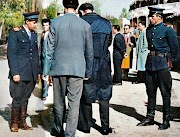May 1st in Communist Albania
Albanian Chronicles Diary
May 1st in Communist Albania
Every regime imposes its own symbols, creating a secular liturgy in which society is required to participate, demonstrating devotion to the symbols of the dictatorship itself. Albania during the communist regime, though proclaimed the first and only atheist state in the world, was no exception to this rule. Despite the absence of an official religion, the regime had its rituals, its "gods," and its sacred symbols around which the cult of power was built and expressed.
One of the most emblematic appointments was undoubtedly May 1st, the workers' holiday. This celebration took on a particularly poignant meaning in Albania, especially from 1948, when the Communist Party renamed itself the Party of Labor, emphasizing a commitment to the centrality of the working class. In the communist system, workers were elevated to the symbols of a "new man," perhaps inspired by Nietzsche's concept of "superman," though reinterpreted through the ideological lens of the regime. This "new man" represented the ideal communist citizen: productive, disciplined, and wholly devoted to the Party. The exact meaning of this expression could be elusive, but its presence in official rhetoric was ubiquitous, serving as a powerful tool for mobilization and collective identity.
May 1st in Albania was much more than a simple labor day celebration; it was an event deeply rooted in the country's social life. I vividly remember the festive atmosphere that permeated the streets that day, a sense of unity and community celebration. An unmissable element of these festivities were the new sandals that my parents bought us each year, distinctive for their shiny white soles. These sandals were not just a symbol of seasonal renewal but also became a sign of festivity and joy for us children, a small luxury that heralded summer.
Dressed in festive, colorful clothes, we children, together with our parents, began the usual long walk, a ritual of joy and community. The route started from the bustling center of Durres, where laughter mixed with the sounds of the festival. We then proceeded to the impressive Roman amphitheater, a silent witness to past centuries, and made our way to the "Vollga" waterfront, where the scent of the sea joined the festivities.
The streets were animated by families and groups of friends, all sharing the pleasure of the day and the joy of being together. The highlight of May 1st was buying the season's first ice creams, a sweet prelude to the approaching summer, and the usual commemorative photo taken by an official photographer. These photographs, over time, have become treasured memories, reflecting with surprising detail my personal evolution year after year. These moments, simple yet precious, were through the eyes of a child, windows into a world of wonder and carefreeness, an idyll that only holiday days could paint.
After spending a joyful afternoon walking through the lively streets of Durres, upon our return home, we found comfort in the family corner in front of the television, still black and white, a witness to a fading era. Once the television was turned on, the scene that unfolded before our eyes was impressively solemn. Cameras captured the crowd of workers and laborers converging from every corner of Albania, not marching in front of an anonymous building but in front of a tribune vibrant with life and power. On that tribune, alongside other influential members of the Labor Party's Executive Committee, sat Enver Hoxha. He, at the center of this power assembly, with a smile that painted him more as an affable grandfather than as the head of state of a nation under strict communist control, was greeted by the masses. At the labor festival, every gesture and every smile were laden with symbolism, with the tribune transformed into a stage from which the architect of the new Albania welcomed the homage of his citizens. The broadcast images emphasized national unity and pride, serving to consolidate the ideal image of cohesion and power that the regime wished to imprint in the mind of every citizen, a collective imaginary of strength and unity under the unwavering guidance of its leader.
Despite May 1st being deeply politicized by the communist regime, my childlike perception of those days was entirely innocent and uninterested in the intricate political meanings. To me, those celebrations represented one of the most exciting and joyful events of my childhood. In Durres, the party was enlivened with particular vivacity, leaving me immersed in the simple joys of a child: new sandals, freshly bought ice creams, and laughter with friends.
The real political heart of the festival beat in Tirana, where the imposing parades dominated the political stage. In front of Enver Hoxha, black and white cameras captured every detail, highlighting each of his smiles as a symbol of absolute authority. As images of Hoxha, the 'supreme leader,' were shown on television across the country, an atmosphere of almost religious veneration was created.
The meticulously coordinated masses paraded in a choreography of loyalty and pride, crafting a narrative of indestructible unity under his guidance.
But for me, far from the power tribunes in Tirana, that smile was just a background detail of a festive day. I did not grasp the weight of that image or the strategies behind that portrayal.
These memories, now that I can look back with a more mature understanding, reveal how complex those celebrations were, imbued with political symbolism. However, I cannot deny the sense of nostalgia for those moments of carefree happiness. May 1st remains in my memory as a time of innocent joy, a vivid reminder of when politics was just a distant echo compared to the sound of laughter and the taste of ice creams.











0 Comments